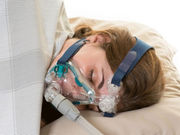Female OSA patients had multiple regions of reduced cortical thickness in superior frontal lobe
FRIDAY, March 16, 2018 (HealthDay News) — Reduced cortical thickness is seen in individuals with obstructive sleep apnea (OSA) versus controls, with multiple regions of reduced thickness seen in the superior frontal lobe in females with OSA, according to a study published online March 6 in PLOS ONE.
Paul M. Macey, Ph.D., from the University of California at Los Angeles, and colleagues examined the influences of OSA on cortical gray matter in male and female patients. Cortical thickness was assessed in 48 patients with mild-to-severe OSA (12 females, 36 males) and 62 controls (22 females, 40 males). OSA-related cortical thinning was identified with high-resolution magnetic resonance imaging.
The researchers found that, compared with other groups, female OSA patients had multiple regions of reduced cortical thickness that appeared bilaterally in the superior frontal lobe. Compared with controls, the general OSA population had significant thinning within the pre- and post-central gyri and the superior temporal gyrus, extending into the insula. Neither increased thickness in OSA versus controls nor positive female OSA interaction effects were seen in any areas.
“The greater cortical injury in cognitive areas of female OSA patients may underlie enhanced symptoms in that group,” the authors write. “The thinning associated with OSA in male and female OSA patients may contribute to autonomic dysregulation and impaired upper airway sensori-motor function.”
Copyright © 2018 HealthDay. All rights reserved.








